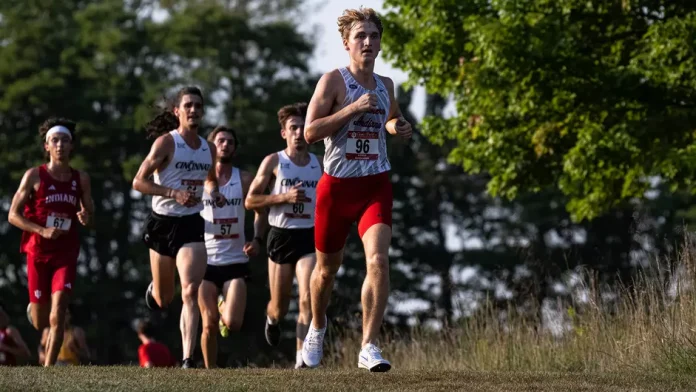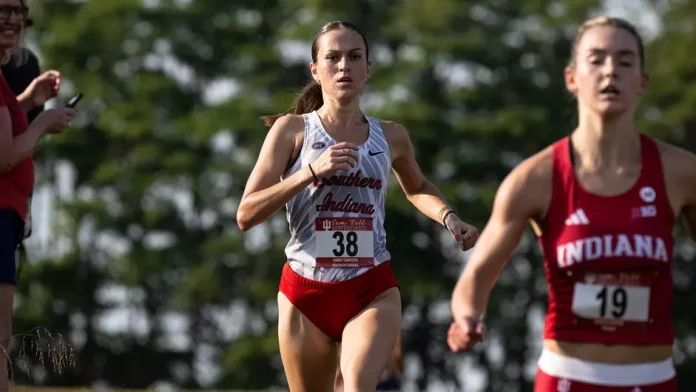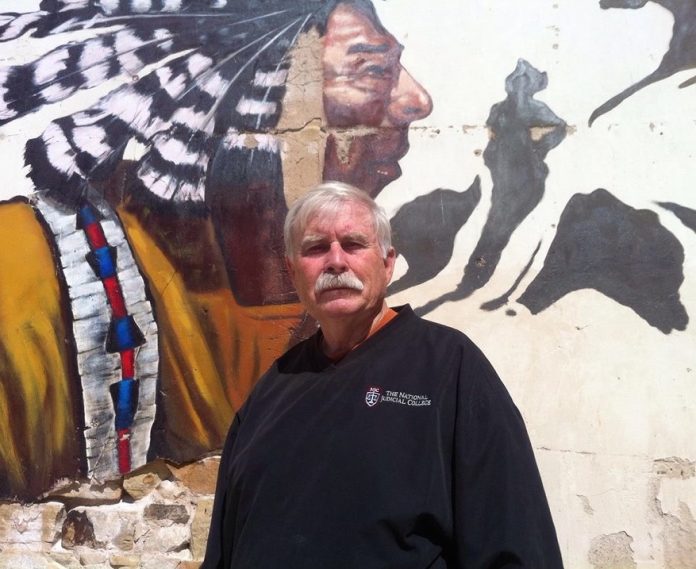BLOOMINGTON, Ind.—Sophomore Alex Nolan (Evansville, Indiana) opened the 2024 season with a fifth-place finish out of 54 competitors to lead University of Southern Indiana Men’s Cross Country at the Sam Bell Invitational Friday evening.
Nolan finished the six-kilometer race in 18 minutes, 44.3 seconds, just over a second back of fourth place.
As a team, the Screaming Eagles were fourth in the four-team field with 92 points. The University of Cincinnati won the event as the Bearcats sent the first four runners across the finish line for a team score of 17 points. Host Indiana University was second with 61 points, while Indiana State University had 73 points for a third-place finish.
Sophomores Tyler Zimmerman (Evansville, Indiana) and Landen Swiney (Du Quoin, Illinois) aided the Eagles with respective placements of 20th and 22nd. Senior Brady Terry (Philpot, Kentucky) was 23rd, though his finish didn’t factor into the team scoring due to technical issues, while sophomore Jackson Collman (Bethalto, Illinois) was 26th.
USI’s top seven was rounded out by sophomore Cole Hess (Cannelton, Indiana) and freshman Andrew Smith (Fishers, Indiana), where were 30th and 32nd, respectively. Sophomore Isaac Stanford (Flora, Illinois) was 33rd and saw his finish factor into the Eagles’ scoring despite being the eight USI runner to cross the finish line.
The Eagles return to action Saturday, September 14 when they compete at the UT Martin XC OVC Preview in Union, Tennessee. The women’s 6k will starts at 9 a.m., while the men’s 8k follows at 10 a.m.
Nolan’s top-five finish leads USI men in opener
Comastri finishes fourth to lead USI women at IU
BLOOMINGTON, Ind.—Senior Audrey Comastri (Indianapolis, Indiana) raced to a fourth-place finish out of 52 competitors to lead University of Southern Indiana Women’s Cross Country at the 2024 season-opening Sam Bell Invitational.
Comastri finished the four-kilometer race with a time of 14 minutes, 23.6 seconds and an average mile pace of 5:47. She finished less than three seconds behind the third-place finisher and a little more than 20 seconds behind the University of Cincinnati’s Claire Curtsinger, who won the race in 14:02.7.
As a team, the Screaming Eagles were fourth of four teams with 86 points. Indiana State University was first with a team score of 33 points, while Cincinnati and host Indiana University were second and third, respectively, with 48 and 58 points.
Aiding the Eagles’ efforts was freshman Hadessah Austin (Attica, Indiana), who was 15th with a time of 14:45.4, while sophomore Zoe Seward (Rochesster, Indiana) was 16th with a time of 14:45.8.
Senior Katie Winkler (Santa Claus, Indiana) and freshman Addison Applegate (Corydon, Indiana) ran to respective finishes of 30th and 31st to round out USI’s top five scorers, while senior Emma Thompson (Mt. Vernon, Indiana) and sophomore Sara Livingston (Jasper, Indiana) wrapped up the Eagles’ top seven with respective finishes of 33rd and 34th.
USI returns to action Saturday, September 14 when it competes at the UT Martin XC OVC Preview in Union, Tennessee. The women’s 6k will starts at 9 a.m., while the men’s 8k follows at 10 a.m.
The History and Implications of Taxing Unrealized Capital Gains

The History and Implications of Taxing Unrealized Capital Gains
by Jos Wallace
AUGUST 31, 2024
Introduction
Taxation of unrealized capital gains, the practice of taxing the increase in value of assets before they are sold, has been a subject of significant debate. While the concept of taxing these gains may seem like a logical approach to ensuring that wealthier individuals pay a “fair share” of taxes, its implementation has historically been fraught with economic challenges. This article delves into the history of taxing unrealized capital gains, particularly in European nations during the 1970s and 1980s, exploring specific examples, the outcomes of these policies, and the potential consequences if such policies were to be reintroduced today.
Historical Context and Examples
The idea of taxing unrealized capital gains gained traction in several European countries during the economic turbulence of the 1970s and 1980s. Governments were grappling with high inflation, economic stagnation, and widening income inequality. In response, they sought to increase tax revenues by targeting the wealthy, who often held significant portions of their wealth in appreciating assets like real estate and stocks.
One notable example is Sweden, which in the late 1970s introduced a tax on unrealized capital gains as part of broader tax reforms aimed at curbing inflation and promoting economic equality. The policy was designed to tax the paper profits of assets that had increased in value, even if the asset holders had not realized those gains by selling the assets. However, the policy quickly encountered significant challenges.
The Swedish experience revealed that taxing unrealized gains created severe liquidity problems for asset holders, particularly those with non-liquid assets such as real estate. Many taxpayers found themselves in the paradoxical situation of owing taxes on wealth that they could not access without selling their assets. This led to a chilling effect on investment, as individuals and businesses became wary of acquiring or holding onto assets that could expose them to substantial tax liabilities without a corresponding increase in cash flow. By the early 1980s, the policy had been repealed due to its adverse effects on investment and economic growth.
Another example can be found in Germany, where a similar approach was attempted in the 1980s. The German government sought to tax unrealized capital gains as part of a broader effort to stabilize the economy and reduce income inequality. However, the policy faced widespread opposition from the business community and was criticized for its complexity and potential to distort investment decisions. The administrative burden of assessing and collecting taxes on unrealized gains proved to be enormous, leading to significant inefficiencies in the tax system. The policy was ultimately abandoned, as the economic malaise it caused outweighed any potential benefits.
Outcomes and Lessons Learned
The experiences of Sweden, Germany, and other countries that experimented with taxing unrealized capital gains offer important lessons. First and foremost, such policies tend to create liquidity issues for taxpayers, forcing them to sell assets prematurely or take on debt to cover tax liabilities. This can lead to a decrease in overall investment, as individuals and businesses become more cautious in their financial decisions.
Moreover, the administrative complexity of taxing unrealized gains cannot be understated. Accurately assessing the value of assets, particularly those that do not have a readily available market price, is a daunting task. This can lead to disputes between taxpayers and tax authorities, as well as increased costs for both the government and the private sector.
Another critical outcome is the potential for economic distortion. When taxpayers are penalized for holding onto appreciating assets, they may be incentivized to engage in inefficient financial behavior, such as selling assets before they are ready or shifting their investments to avoid the tax altogether. This can lead to misallocation of resources and reduced economic growth.
Conclusion
The historical attempts to tax unrealized capital gains in countries like Sweden and Germany serve as cautionary tales. While the goal of increasing tax revenues and promoting economic equality is laudable, the unintended consequences of such policies can be severe. The liquidity issues, administrative burdens, and economic distortions that arise from taxing unrealized gains have repeatedly proven to outweigh the potential benefits.
If a nation were to reintroduce a tax on unrealized capital gains today, it would likely face similar challenges. Policymakers would need to carefully consider the potential impact on investment, economic growth, and the overall efficiency of the tax system. While the idea of taxing unrealized gains may appeal to those seeking to reduce wealth inequality, history suggests that the practical difficulties and economic risks associated with such a policy make it a less-than-ideal solution.
In conclusion, the history of taxing unrealized capital gains demonstrates the importance of balancing the desire for increased tax revenue with the need to maintain a healthy, functioning economy. Should any nation consider implementing such a policy in the future, it would be wise to learn from past experiences and approach the idea with caution, ensuring that the potential consequences are fully understood and addressed.
USI to host Evansville Philharmonic Orchestra’s 90th Season Preview Concert
The University of Southern Indiana will host the Evansville Philharmonic Orchestra for its 90th-season preview concert at 5 p.m. Thursday, September 12 in the USI Performance Center. The concert is open to the campus community and public at no charge.
“I’m thrilled to have the Philharmonic here on campus this Fall. No city where I’ve ever lived has loved and embraced its philharmonic as much as Evansville,” says Dr. Del Doughty, Dean of USI’s College of Liberal Arts. “I hope that our young people here will see that at the performance and get behind the music.”
Over its 90-year history, the Evansville Philharmonic Orchestra continues to grow as one of the finest regional orchestras of its kind in the country, reaching thousands of audience members young and old.
“As we embark upon our 90th anniversary season, I am thrilled to present our very first season preview concert at USI,” says Roger Kalia, Music Director. “We will perform various highlights from our season on this concert with music by Dvorák, Tchaikovsky, Michael Jackson, and John Williams, among others. I look forward to future collaborations with USI, and I hope that you will all join us for this very special event.”
To learn more about this event, contact Doughty at ddoughty1@usi.edu or the Evansville Philharmonic Orchestra at 812-425-5050.
CITY-COUNTY OBSERVER “MOLES” DRESSED UP AND READY TO ATTEND ANNUAL AWARDS LUNCHEON
The City-County Observer “Moles” are all dressed up and ready for the big day!
BY JOHNNY KINCAID
AUGUST 31, 2024
On Friday, September 20, 2024, the CCO “MOLES” will be presented to this year’s “Community Service Awards” winners at a sold-out luncheon at Bally’s.-Evansville

This year’s keynote speaker is United States Senator Mike Braun who will participate in a casual question-and-answer session.
This year’s award honorees are diverse and highly respected in our community. The winners are comprised of a local scientist whose work is getting national attention, a popular meteorologist, and two state senators. well-known local judge.
We will make a formal detailed announcement of this year’s awards winners sometime next week.
FOOTNOTES: The “CCO MOLES” were created with recycled plastic and are presented to our annual award winners.
Mosquito Bite Prevention Advised
EVANSVILLE, August 30th, 2024-One sample group of mosquitos from a surveillance trap collected within Vanderburgh County in zip code 47715. This is the first positive test in Vanderburgh County this year. The Vanderburgh County Health Department is advising the public to take precautions against mosquito bites due to the presence of West Nile virus being found in samples throughout the state of Indiana and the risk of mosquitos transmitting the disease progressing thru the rest of the summer.
West Nile virus can cause West Nile fever, a mild form of the illness, which can include fever, headache, body aches, swollen lymph glands or rash. Some people will develop a more sever form of the disease affecting the nervous system, including inflammation in the brain and spial cord, muscle paralysis, or even death. People who think they may have West Nile virus should see their healthcare provider.
The Health Department is asking residents to:
• Limit time outdoors between dusk and dawn, when mosquitos are most active. Where light colored clothing, pants, and long sleeves when possible.
• Use insect repellant containing DEET, Picaridin, or Oil of Lemon Eucalyptus. (Products containing DEET should not be used on infants aged <2 months of age and those containing Oil of Lemon
Eucalyptus should be used on infants <3 years of age); and
• Make sure your property is free of any standing water, which could be breeding grounds for mosquitos that carry the virus. Empty flowerpots, buckets, old tires, trash cans, and clogged gutters. Keep the grass cut and landscaping trimmed as adult mosquitos use overgrown areas as safe placed to rest.
LABOR DAY
LABOR DAY
GAVEL GAMUT
By Jim Redwine
My father’s father was killed in an accident when my dad was nine years old. My father had to quit school in his third-grade year to help his mother support the family. He went to work in an independent coal mine running water to the older workers. The mine was unregulated by state or federal law. The shaft was supported with tree limbs for beams and the coal produced was high sulfur. The dust he breathed helped lead to his death from cancer when he was fifty-eight. He left the mine which closed when the shaft collapsed upon some of the miners. Dad was out of the mine on a water run at the time the supporting tree limbs gave way.
It was not just coal dust that contributed to his health problems. When he had to search out another job after the cave-in, he found work in a cement plant where he breathed in cement dust for several years. He lost that job when he had a heart attack at age thirty-three but had no health nor unemployment benefits from the company. He was out of work and bedridden for six months while my mother nursed him back to health. They were without outside income or insurance during that period. That is why my father went into insurance sales. He and my mother were strong supporters of workers’ rights who revered Labor Day just as they did July Fourth. They knew that law was essential to ensure safe working conditions. Such things as child labor laws, restricted work hours and days, health precautions and minimum wage requirements are not socialist ideals but are some of the building blocks of our economy. Labor Day is a celebration of America’s commitment to fairness, equality and good economics in the workplace.
Of course, as Peg points out, for about half of America’s workforce the bulk of their work is in their homes. Peg says it is ironic that we have a national holiday named Labor Day. She asks, “What about some fairness and equality in labor around the home and, what’s more, what about some recognition not just for ‘child labor’ but for the labor of having a child?” I should have seen this discussion coming when I casually mentioned my days of manual labor for hire.
According to Peg, Mother’s Day is a fine recognition of mothers but flowers once a year just doesn’t cut it. “Where’s the beef?” she asks. “Where is the minimum wage for round-the-clock cleaning, cooking, laundry, deliveries, nursing, sewing, yard work, gardening, child care, carpooling, schedule maintenance, bookkeeping, counseling and furnishing a sympathetic sounding board for every hurt feeling? And what about some time off occasionally? How about some time alone with peace and quiet and a cool drink that somebody else brings to me?”
Well, Gentle Reader, you most likely fall on whichever side of this one-way discussion your gender dictates. So, for now, I plan to change the subject and return to a topic I may be able to discuss without interruption, that is, Labor Day. Oh, not the one Peg is on about, but the one declared by President Grover Cleveland in 1894. So here goes.
Peg got agitated as we watched numerous male politicians on television exhort the wonders of the American, mostly male, workers whose harsh working conditions in the 19th and 20th centuries caused the birth of Labor Day. When it came to Peg’s complaints about work in the home, I felt duty bound to point out that husbands were responsible for much of her complained about female labors. After all, someone has to wear the clean clothes, eat the food and watch the kids play soccer and baseball. It is not all beer and TV you know. And if anyone had ever asked men to have the kids, who is to say we might not have considered it.
Further, most men have no problem with wearing the same comfortable t-shirt and Levi’s for a week or so. And on top of that, beer and chips have plenty of nutritional value to sustain men through football season. I told Peg, gently, that she was being disingenuous in her analysis of the significance of Labor Day. Labor Day for male workers was much like the right to vote for women. While women were wearing white, marching and singing songs about freedom, we men were busy gathering at bars talking about seeking fair working conditions. Men gladly organized for shorter work weeks and safer working conditions as women sought not just the right to vote, but also better working conditions and fair and equal treatment everywhere. The two movements fed off the synergy of one another and, together, made life better for both men at work and women at home and work.
Of course, those intertwined crusades for justice made our country better for us all. So, I guess if Peg thinks Labor Day is truly about all labor, I will, in the spirit of home harmony, agree. After all, I’m getting hungry and the game’s about to start on tv and I’m hoping Peg will bring me chips and a beer.
For more Gavel Gamut articles go to www.jamesmredwine.com
Historic Preservation Commission Meeting
Historic Preservation Commission
SEPTEMBER 3, 2024
5:30 P.M.
AGENDA
| 1. | CALL TO ORDER |
September 3, 2023 Agenda Attachment:
| 2. | ROLL CALL |
| 3. | APPROVAL OF MINUTES – July 1, 2024 |
July 1, 2024 Minutes (unsigned) Attachment:
| 4. | NEW BUSINESS |
a. 821 SE Riverside 821 SE Riverside COA Application Attachment:
b. 22 Chandler
c. Updating Preservation Area Guidelines Historic Preservation Guidelines and Procedures Attachment:
d. Realtors Association Meeting
e. Riverside Historic District Mailing Letter
f. Indiana Landmarks Matching Grant Opportunity 2025 HPF Announcement for IL Attachment:
g. New Meeting Date and Time
| 5. | OLD BUSINESS |
a. 24-HPOCA-03 Charles Capshaw, 724 SE 2nd Street Revised Site Plan
b. 615 SE Riverside Update
c. 810 SE 1st Street Update
d. 813 SE Riverside Update
e. Update Demolition by Neglect Ordinance
| 6. | MISCELLANEOUS |
| 7. | ADJOURNMENT |











